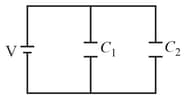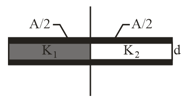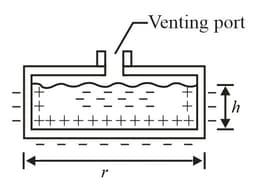An air-filled parallel-plate capacitor has a capacitance of . The separation of the plates is doubled, and wax is inserted between them. The new capacitance is . Find the dielectric constant of the wax.

Important Questions on Capacitance
In Fig., how much charge is stored on the parallel-plate capacitors by the battery? One is filled with air, and the other is filled with a dielectric for which both capacitors have a plate area of and a plate separation of .

(f) What is in the limit as
Figure shows a parallel plate capacitor with a plate area and separation . The left half of the gap is filled with material of dielectric constant the right half is filled with material of dielectric constant What is the capacitance?

In Fig., , and . If no capacitor can withstand a potential difference of more than without failure, what are (a) the magnitude of the maximum potential difference that can exist between points and and (b) the maximum energy that can be stored in the three-capacitor arrangement ?

As a safety engineer, you must evaluate the practice of storing flammable conducting liquids in nonconducting containers. The company supplying a certain liquid has been using a squat, cylindrical plastic container of radius and filling it to height which is not the container's full interior height (as shown in Fig.). Your investigation reveals that during handling at the company, the exterior surface of the container commonly acquires a negative charge density of magnitude (approximately uniform). Because the liquid is a conducting material, the charge on the container induces charge separation within the liquid. (a) How much negative charge is induced in the Centre of the liquid's bulk? (b) Assume the capacitance of the central portion of the liquid relative to the ground is . What is the potential energy associated with the negative charge in that effective capacitor? (c) If a spark occurs between the ground and the central portion of the liquid (through the venting port), the potential energy can be fed into the spark. The minimum spark energy needed to ignite the liquid is In this situation, can a spark ignite the liquid?

